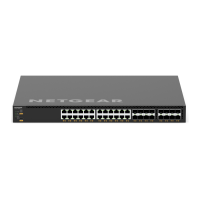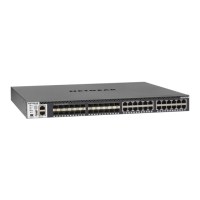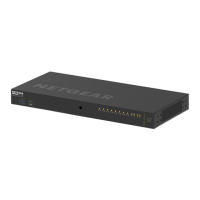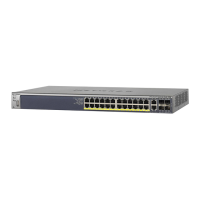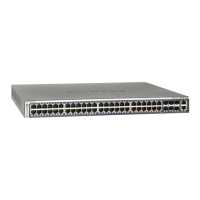Configure Quality of Service
482
M4300 Series and M4300-96X Fully Managed Switches User Manual
• Mirror
• Redirect
• T
wo Rate Policy. With the two-rate policer
, you can enforce traffic policing according
to two separate rates: Committed Rate and Peak Rate.
• Mark IP DSCP. This lists the keywords for the known DSCP values from which one
can be selected.
The list includes 'other' as an option for the remaining values.
• Simple Policy. Use this attribute to establish the traffic policing style for the specified
class.
This command uses single data rate and burst size resulting in two outcomes
(conform and violate).
13. If you select the Simple Policy attribute, you can configure the following fields:
• Color Mode. This lists the color mode.
The default is Color Blind.
- Color Blind
- Color A
ware
Color
Aware mode requires the existence of one or more color classes that are
valid for use with this policy instance. A valid color class contains a single,
non-excluded match criterion for one of the following fields (provided the field
does not conflict with the classifier of the policy instance itself):
- CoS
- IP DSCP
- IP Precedence
• Committed Rate
. This value is specified in the range 1 to 4294967295
kilobits-per-second (Kbps).
• Committed Burst Size
. This value is specified in the range 1 to 128 KBytes.
The
committed burst size is used to determine the amount of conforming traffic allowed.
• Conform Action. This lists the actions to be taken on conforming packets according
to the policing metrics, from which one can be selected.
The default is send.
• Violate Action. This lists the actions to be taken on violating packets according to the
policing metrics, from which one can be selected.
The default is send.
• For each of the action selectors one of the following actions can be taken:
• Drop.
These packets are immediately dropped.
• Mark IP DSCP. These packets are marked by Dif
fServ with the specified DSCP
value before being presented to the system forwarding element. This selection
requires that the DSCP field be set.
• Mark CoS. These packets are marked by Dif
fServ with the specified CoS value
before being presented to the system forwarding element. This selection requires
that the Mark CoS field be set.
• Mark CoS As Secondary C
oS. Select this option to mark all packets in a traffic
stream with the specified secondary CoS queue number. Use the Class of Service
field to select the CoS value to mark in the priority field of the 802.1p header in the
secondary (inner) 802.1Q tag of a double VLAN tagged packet. If the packet does
not already contain this header, one is inserted.
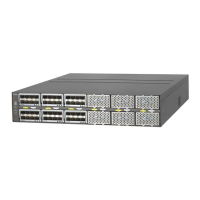
